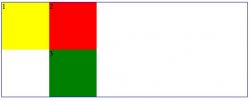So I got myself through code academy's web fundamentals. 100%, thank you very much haha.
After dabbling with the idea of creating my own website and actually coming across a similar question on here a while back, I'm here with my own question.
Basically, I have different divs of various sizes.
128x128, 270x270... so forth and so on. But my one trouble comes through the fact I'm trying to get their positions next to one another as well as below. I just don't know where to go from here...
div
{
height:128px;
width:120px;
color:white
margin: 0 5px 0 0;
}
how would i get one div next to it (and then next to it)
and then below as well.
any answers would be helpful. Thank You!
After dabbling with the idea of creating my own website and actually coming across a similar question on here a while back, I'm here with my own question.
Basically, I have different divs of various sizes.
128x128, 270x270... so forth and so on. But my one trouble comes through the fact I'm trying to get their positions next to one another as well as below. I just don't know where to go from here...
div
{
height:128px;
width:120px;
color:white
margin: 0 5px 0 0;
}
how would i get one div next to it (and then next to it)
and then below as well.
any answers would be helpful. Thank You!


